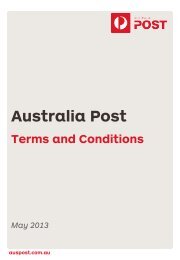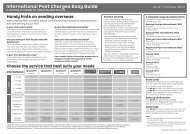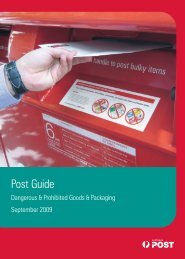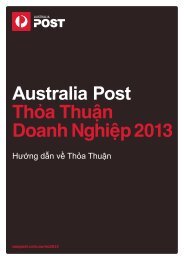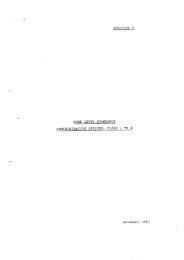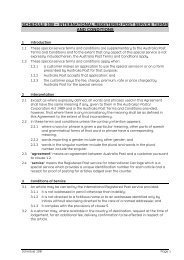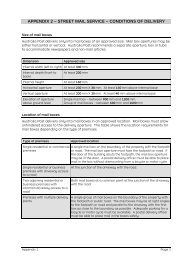2009-10 Annual Report - Australia Post
2009-10 Annual Report - Australia Post
2009-10 Annual Report - Australia Post
Create successful ePaper yourself
Turn your PDF publications into a flip-book with our unique Google optimized e-Paper software.
29 Financial and capital risk management (continued)<br />
(h) interest rate risk management (continued)<br />
interest rate swap contracts<br />
under interest rate swap contracts the corporation agrees to exchange the difference between fixed and floating rate interest amounts calculated<br />
on agreed notional principal amounts. such contracts enable the corporation to mitigate the risk of changing interest rates on the fair value of issued<br />
fixed rate debt held.<br />
the following table details the notional principal amounts and remaining terms of interest rate swap contracts as at balance date.<br />
Fixed for floating interest<br />
1–2 years<br />
2–5 years<br />
Fixed<br />
interest<br />
rate<br />
%<br />
6.25<br />
5.25<br />
corporation and consolidated<br />
20<strong>10</strong> <strong>2009</strong><br />
notional<br />
principal<br />
amount<br />
$m<br />
230.0<br />
325.0<br />
Fixed<br />
interest<br />
rate<br />
%<br />
–<br />
5.66<br />
notional<br />
principal<br />
amount<br />
$m<br />
–<br />
555.0<br />
555.0 555.0<br />
the interest rate swap contracts settle on a six-monthly basis. the floating rate on the $230 million tranche is six-monthly BBsW minus 6.75 basis points,<br />
and the floating rate on the $325 million tranche is six-monthly BBsW plus 118.125 basis points.<br />
interest rate swap contracts are designated as fair value hedges in respect of interest rates. the gain or loss from remeasuring the hedging<br />
instrument at fair value is recorded in profit or loss and, to the extent that the hedge is effective, the carrying amount of the borrowing is adjusted<br />
by the gain or loss attributable to the hedged risk through profit or loss.<br />
interest rate sensitivity<br />
the table below details the interest rate sensitivity analysis of the corporation and the group at the reporting date, holding all other variables<br />
constant. a 150 (<strong>2009</strong>: 75) basis point change is used to quantify the possible risk based on australian Government department of Finance and<br />
deregulation guidance. the sensitivity analysis below has been determined based on the exposure to interest rates from financial instruments<br />
at the reporting date and the stipulated change taking place at the beginning of the financial year and being held constant throughout the<br />
reporting period.<br />
a positive number indicates an increase in profit after tax, while a negative number indicates a reduction in profit after tax. there is no sensitivity<br />
on equity.<br />
impact on profit after tax at reporting date, with all other variables held constant of a:<br />
150 (<strong>2009</strong>: 75) basis point increase in interest rates<br />
150 (<strong>2009</strong>: 75) basis point decrease in interest rates<br />
20<strong>10</strong><br />
$m<br />
consolidated corporation<br />
the interest-bearing assets and liabilities on which the sensitivity is shown in the table above, are considered representative of the corporation and<br />
group’s average interest rate exposure for the years ended 30 June <strong>2009</strong> and 30 June 20<strong>10</strong>.<br />
4.7<br />
(4.7)<br />
<strong>2009</strong><br />
$m<br />
1.8<br />
(1.8)<br />
20<strong>10</strong><br />
$m<br />
4.7<br />
(4.7)<br />
<strong>2009</strong><br />
$m<br />
1.8<br />
(1.8)<br />
AustrAliA <strong>Post</strong> AnnuAl rePort <strong>2009</strong>–<strong>10</strong> | Financial and statutory reports 91




